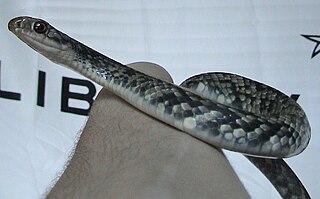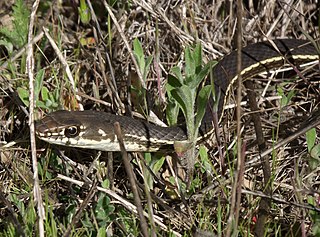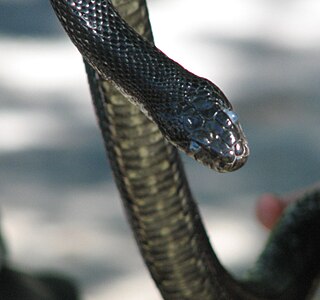
Pantherophis obsoletus, also known commonly as the western rat snake, black rat snake, pilot black snake, or simply black snake, is a nonvenomous species of snake in the family Colubridae. The species is native to central North America. There are no subspecies that are recognized as being valid. Its color variations include the Texas rat snake. Along with other snakes of the eastern United States, like the eastern indigo snake and the eastern racer, it is called “black snake”.
Yellowbelly may refer to:

Hardwicke's rat snake, also known commonly as the glossy-bellied racer, Gray's rat snake, and the spotted bellied snake, is a species of snake in the family Colubridae. The species is native to Asia. There are three recognized subspecies.

Masticophis flagellum is a species of nonvenomous colubrid snake, commonly referred to as the coachwhip or the whip snake, which is endemic to the United States and Mexico. Six subspecies are recognized, including the nominotypical subspecies.

Coluber constrictor flaviventris, commonly known as the eastern yellow-bellied racer, is a subspecies of the eastern racer, a non-venomous colubrid snake. It is endemic to North America.

The eastern racer, or North American racer, is a species of nonvenomous snake in the family Colubridae. The species is endemic to North America and Central America. Eleven subspecies, including the nominotypical subspecies, are recognized, which as a group are commonly referred to as the eastern racers. The species is monotypic in the genus Coluber.

The southern black racer is one of the more common subspecies of the nonvenomous Coluber constrictor snake species of the Southeastern United States. The subspecific name priapus refers to the proximal spines of the hemipenes being much enlarged into basal hooks, which is characteristic of this subspecies. These snakes are quite active during the day, which increases the chance of sightings. They eat almost any animal they can overpower, including rodents, frogs, toads, and lizards. Members of this species generally do not tolerate handling – even after months in captivity – and typically strike and flail wildly every time they are handled, often defecating a foul-smelling musk, a common defense against predators in snakes. Adults of the species are usually thin with a jet-black dorsal side with a grey belly and white chin. They are quite fast, giving them the name "racer".

Coluber constrictor oaxaca, commonly known as the Mexican racer, is a nonvenomous colubrid snake, a subspecies of the eastern racer.

Coluber constrictor etheridgei, commonly known as the tan racer, is a subspecies of nonvenomous snake in the family Colubridae, a subspecies of the eastern racer. The subspecies is native to the southern United States.

Pantherophis emoryi, commonly known as the Great Plains rat snake, is a species of nonvenomous rat snake in the family Colubridae. The species is native to the central part of the United States, from Missouri to Nebraska, to Colorado, south to Texas, and into northern Mexico.

The crayfish snake, also known commonly as the glossy crayfish snake, the glossy swampsnake, the glossy water snake, and the striped water snake, is a species of semiaquatic snake in the subfamily Natricinae of the family Colubridae. The species is endemic to the southeastern United States, and preys mainly on crayfish.

The California whipsnake, also known as the striped racer, is a colubrid snake found in habitats of the coast, desert, and foothills of California.

Coluber constrictor foxii, commonly known as the blue racer, is a subspecies of Coluber constrictor, a species of nonvenomous, colubrid snake commonly referred to as the eastern racer.

The bullsnake is a large, nonvenomous, colubrid snake. It is a subspecies of the gopher snake. The bullsnake is one of the largest/longest snakes of North America and the United States, reaching lengths up to 8 ft.

Pantherophis alleghaniensis, commonly called the eastern rat snake, is a species of non venomous snake in the family Colubridae. The species is endemic to North America.

The northern black racer is a subspecies of the eastern racer, a nonvenomous snake in the family Colubridae. Their geographic range extends from southern Maine to northern Georgia and westward to central Kentucky and eastern Ohio. Their occupancy is dependent on the availability of large patches of open habitats.















